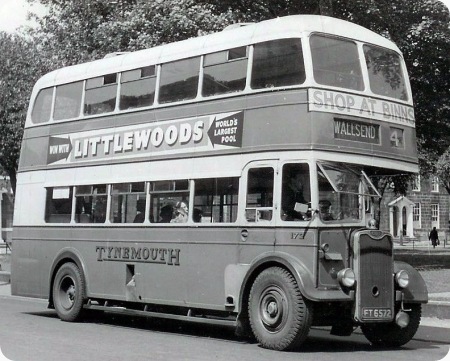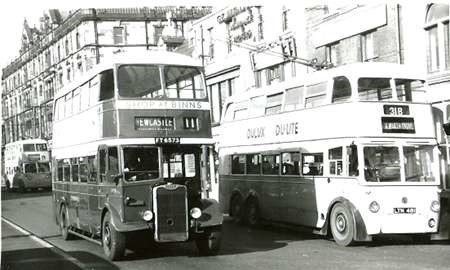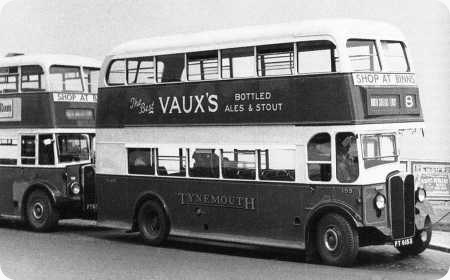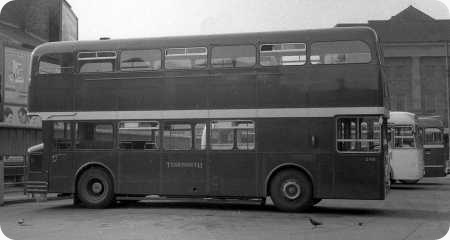
Photograph by ‘unknown’ if you took this photo please go to the copyright page.
Tynemouth and District
1949
Guy Arab III
Pickering H56R
Here’s another odd ball for you, it’s a Guy Arab from Northern General’s Tynemouth and Wakefields subsidiary. I would guess from the registration it’s from about the late 40’s. I don’t know how many were in the batch or who built the bodies, but they’re unlike any other of Northern’s Guy’s that I know of. Northern were huge fans of the Gardner 5LW, and the vast majority of their Guy’s were fitted with them, but for reasons unknown to myself these vehicles came with a Meadows engine, were they perhaps re bodies? The engines were later changed and many had the 5LW fitted as replacements, but at least one of them ended up with an AEC unit, this ones also got the Indian Chief radiator cap, I wonder if that survived? I can remember them, but by the time I started at Percy Main they were long gone.
Photograph and Copy contributed by Ronnie Hoye
23/05/12 – 09:32
It looks very like a locally built Northern Coachbuilders body. Sheffield used them as an alternative to Weymann. Sheffield’s last were delivered in 1950, I think NCB closed shortly afterwards.
Ian Wild
23/05/12 – 09:33
This appears to be a Northern Caochbuilders bodied Guy Arab III Tynemouth had some similar chassis with Weymann bodywork Northern General also bought NCB bodied Guys but these had a short life with NGT.
Chris Hough
23/05/12 – 09:35
The bodies on these Meadows 6DC630 engined Arab IIIs, of which there were ten delivered in 1949, were by Pickering, and reputedly had metal frames. This picture, and some accompanying information, may also be found on this site:- //www.flickr.com/ From this, it appears that all the Meadows engined Arabs, apart from No. 169, which received a 5LW, were re-engined with AEC 7.7s. The Meadows unit was very compact – like contemporary Dennis and Daimler designs, the timing gears were located at the rear of the engine – and the Meadows engined Arab had a short bonnet that could not accommodate the 6LW. Most operators that purchased Meadows engines replaced them with alternative power plants at the first C of F renewal or earlier. Though powerful, this motor had reliability problems – it was rumoured that the troublesome crankshafts were sourced from eastern Europe – and, by the standards of the time, it was deemed to be fuel thirsty, though it would probably compare favourably with the dipsomaniac beasts of the present day.
Roger Cox
23/05/12 – 09:36
I’m only guessing but, going by the style of the upper deck front windows I’d say they were Northern Coach Builders bodies. It ties in with the operating area, anyway.
Eric Bawden
23/05/12 – 09:37
Coach builder was Northern Coach Builders of locally Newcastle.Yorkshire Woollen had some identical buses.The photograph must have been taken on a hot day judging the way the driver has had to open the windscreen. If only you could do that on say a Wright bodied Volvo.
Philip Carlton
23/05/12 – 09:38
What a wonderful posting! and a perfect compliment to last year’s debate about Pickering utility bodies, because that’s who built these. There were ten of them, FT 6565-74 and they were delivered in 1949. I believe these were Pickering’s only post war double deckers. It has a strong hint of Northern Coachbuilders about it and as NCB probably had a full order book at the time, perhaps Pickering were able to offer a quicker delivery and of course, they had done a lot of work for Northern General previously. I think the result was a very fine looking vehicle!
Chris Barker
Ronnie – the body on this Guy Arab Mark Three is by Northern Coachbuilders. Northern Coachbuilders were based in Newcastle and bodied both buses and trolleybuses for Newcastle Corporation amongst others and ceased trading around 1951.
Northern General also had some Arab Threes with Northern Coachbuilders bodies. One such bus was 1236 BCN 136, which had the typical Guy Arab ‘snout’. The Meadows engine, whilst having a cubic capacity 10.32 litres was fairly compact and didn’t need the extended bonnet required by the physically larger Gardner 6LW. However, the Meadows engine proved unreliable and most were replaced by engines of other makes – usually a Gardner but also AEC and in the case of Midland Red their own K type.
Michael Elliott
23/05/12 – 09:40
According to my 1962 British Bus Fleets book, this bus is a 1949 Guy Arab III with a Pickering body.
Stephen Bloomfield
Thanks everyone I have replaced all but one of the ?s any offers on the seating capacity.
Peter
23/05/12 – 10:29
According to BBF 10 the vehicle seating capacity was 56.
Stephen Bloomfield
———
23/05/12 – 16:48
A correction to my earlier claim, there were apparently thirteen of these bodies, the ten Guy’s and three on re-conditioned AEC Regents of 1937, also for Tynemouth, FT 4220-4222. I wonder if they were ever photographed?
Chris Barker
23/05/12 – 16:49
The information on the flickr link that Roger provided says that these Pickering bodies were designed to resemble NCB bodies. Notice the difference in height between the front upper deck windows and the side windows, and compare that with a real NCB body here //www.flickr.com
Peter Williamson
24/05/12 – 08:16
Chris, three of the Regents you mention – FT 4220/2 were sold to Provincial in 1957 to replace some of the vehicles they lost in a garage fire, you can find pictures of some of them on the Provincial Bus Enthusiasts Website, there is also a picture of one of them with its pre war front entrance Weymann body
Ronnie Hoye
24/05/12 – 08:17
I don’t think there’s a difference in depth, just a deep valance moulding over the windows. BH & D used to do the same, presumably because they both ran in sunny areas! It certainly makes a difference to the appearance.
David Beilby
25/05/12 – 07:38
Is it possible that Pickering used NCB frames for these bodies?
Eric Bawden
26/05/12 – 06:54
Apparently not, Eric. According to the info on the Flickr posting they were all-metal, whereas NCB only built composite bodies.
Peter Williamson
26/05/12 – 20:15
Is it not possible that these bodies were built on Park Royal frames? The profiles are very similar to the standard Park Royal body, also built by Guy themselves, on Arab IIIs.
Roger Cox
02/01/13 – 07:45
As a Geordie can I please clarify this is a Pickering body, not NCB. NCB bodies did not have the slight curve (taper?) to the front upper deck windows.
I used to see these when I was a young lad.
Peter Stobart
02/01/13 – 14:21
Talking about Guys with Meadow engines, LTE’s G436 was a speculative venture in 1949 by Guy, anxious to keep bus production going after the war, with London orders if possible. It employed an updated Guy Arab III chassis, with a Meadows 10.35 litre engine, fluid flywheel and pre-selector gearbox. It had a Guy body (5-bay) built on Park Royal frames that looked loosely like an RT forever allocated to a one-bus backwater route, the usual destiny for LTE’s non-standard buses, it was withdrawn in 1955, then went to Jugoslavia.
See here: www.modelbuszone.co.uk/
Chris Hebbron
03/01/13 – 06:24
It is rumoured that G436 was either "gifted" or sold at a very reduced price to the Tram and Trolleybus Department of LTE as a tempter for future orders for tram replacement buses. The chassis was modified from the standard Arab III to allow the fitment of RT class bodywork, though G436 itself had the usual provincial style Park Royal body. A second chassis, designed to accept all the standard Park Royal and Weymann RT8 bodies of the RT class, was offered by Guy, but never delivered. G436 had a full air operated braking system, together with a fluid flywheel and an air operated four speed preselector gearbox. As far as is now known, the 10.35 litre Meadows 6DC630 engine was fully rated at 130 bhp, which would have made the bus decidedly more sprightly than the RT/RTL/RTW family which had engines de-rated to 115 bhp. Quite apart from the uphill struggle against London Transport’s infatuation with standardisation, the dubious reliability of the Meadows unit would have handicapped Guy’s attempt to get a postwar foothold in the London market. Perhaps the GS order was some kind of consolation prize. G436 spent its final two years or so with LTE on the short 121 route between Ponders End and Chingford. A certain 13 year old Guy fan made a special pilgrimage from Croydon to Chingford in the summer of 1955 to see this bus and sample it as a passenger. After waiting patiently at length for its arrival, and observing only RTs on the service, an enquiry put to one of the RT drivers elicited the information that G436 had been withdrawn from service at the end of February!
Roger Cox
19/05/16 – 06:18
Much has been written about the origins of these Pickering double deck bodies for Tynemouth, but this much I know.
I bought a secondhand Britbus model of G436 the London Transport Meadows engined Park Royal bodied Guy. Firstly after dismantling it, I filed away the rain strip over the top of the front upper deck windows. Secondly I replaced the half drop windows with sliders. It is often difficult to remember what the rear of a bus looked like without the aid of photographs. But, based on memory I deepened the rear emergency windows on the top deck at the rear of the bus and placed a vertical dividing strip down the rear staircase/ platform window. Finally I repainted it in Tynemouth livery, added appropriate transfers and Hey Presto, what did I end up with a Pickering bodied Guy.
So I submit that these bodies had Park Royal frames and were panneled and completed by Pickering.
Anon
13/04/18 – 05:47
I agree that this appears to have been built on Park Royal frames, the shortened bays on the trailing edge of the rear axles the clue. Thereafter its all cosmetic work, but the fact these were built on sturdier ground than Pickering’s wartime contributions suggests imported metal frames. NCB were all timber framed bodies and likewise of dubious quality apart from the final sanctions which were of ECW outline.
Keith
19/04/18 – 06:47
I can remember these vehicles operating on this service, although they were soon replaced by more modern vehicles. Indeed it seemed to me that this route (Whitley-Wallsend-Gateshead) often received new vehicles to operate it, displacing earlier vehicles to other routes. It was also noticeable that routes were allocated specific batches of vehicles to operate them. Living in Whitley Bay, other routes that I was familiar with were the 5 (Newcastle-Whitley Bay Cemetery) operated by the ECW rebodied TD5s, 7 (North Shields Ferry-Blyth) operated by NCB bodied AEC Regents, and 8 and 12 (North Shields Ferry-Whitley Bay Bandstand) operated by Weymann bodied AEC Regents.
One other point, the vehicle in the photo is carrying the route number 4, but at some time, it was renumbered 1. I have a timetable from 1956 when it was still numbered 4, but in the timetable for 1961, it has become the 1. Does anyone know when it was renumbered? The present day 1 is a descendant of this route, although in order to serve various housing estates, it follows a much more tortuous route than was the case back then. It was also numbered 301 for a lengthy period.
John Gibson
20/04/18 – 06:45
The renumbering of this route from 4 to 1 took place when the route was extended at the Gateshead end to Lobley Hill, and I think this happened in 1956. I remember that my aunt moved to Cullercoats, and the first time we went there it was service 4 but the next time it was service 1: I think that she moved house in 1956.
The renumbering was necessary because the route became a joint operation with Northern when it was extended to Lobley Hill, and Northern already had a route 4. Tynemouth route 1 (Clousden Hill – Wallsend – Willington Square) became route 4.
Paul Robson
 Vehicle reminder shot for this posting
Vehicle reminder shot for this posting
03/12/20 – 06:23

A rare photograph of Tynemouth Guy Arab III FT 6573 No 173 in the Fleet with Pickering H56R body leaving The Haymarket, Newcastle for the coast. Its blind has not been reset for the return journey. The date is probably mid 50s when shot and mid morning judging by the long shadow cast on the MCCW, BUT 9641T No.481 corporation trolley being overtaken and about to leave the stop on its journey to Polwarth Drive, Gosforth.
Ray Jackson
04/12/20 – 12:37
The bus would have turned right coming out of the old Haymarket Bus Station, then left round the back of the South African War Memorial onto Northumberland Street.
It’s now a few yards further on, and on Barras Bridge heading towards The Great North Road. It will stay in the outside lane, as just a few hundred yards further on, it will turn right into Jesmond Road, heading towards Jesmond, then the Coast Road.
This was the short lived revised, cream top livery, which was only around for a couple of years, so not every vehicle in the fleet had it. In 1958, the red top version was introduce, and the MCW Orion bodied Leyland PD3/4’s were the first to receive it.
Ronnie Hoye





